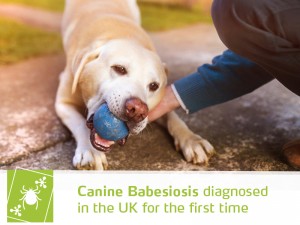
Canine Babesiosis diagnosed in the UK for the first time

Babesiosis, a tick-borne disease that can be fatal for dogs, has been recently diagnosed in Essex. Two of the infected dogs did not survive and three other dogs needed intensive support treatment and blood transfusions.
It's the first time this disease has been diagnosed in the UK and the affected dogs have not travelled outside England. New outbreaks are to be expected from now on since each female tick can produce up to 1000 eggs and it is likely for the disease to spread. The situation is causing a wave of concern all across the UK.
Babesiosis is caused by single-celled protozoan parasites that are transmitted by ticks. They can also be transmitted through blood transfusions and biting although it is less common. Dogs of any age or breed can be affected. These parasites can be found inside our pet's red blood cells and cause the immune system to destroy its own red blood cells, leading to a severe anaemia.
Affected dogs can show a wide range of clinical signs and the disease can go from mild to acute with some dogs deteriorating quickly. Clinical signs include lack of energy, lack of appetite, weight loss, fever, pale gums, red or brown urine, an enlarged abdomen and yellow or orange skin (jaundice).
The best way to avoid this disease from spreading and to protect your pet is to keep your dog's tick control treatment up-to-date and make sure you are using products that are effective against ticks. Consult with your vet so he or she can recommend an adequate product to protect your dog.
It's unlikely for a tick to transmit diseases if it has been attached for less than 24 hours. For this reason it might be worth checking your pet for ticks after walks and remove them as soon as possible. Ticks can attach anywhere on the dog's skin but they tend to be found on their face, on their tummy and on their feet.
When you come home from walks smooth your dog's fur all over, go through your dog's hair brushing it back and look for ticks. If you find any, use gloves and please remember to use a tick hook to make sure the whole tick is removed and that there is no head or any mouth parts left behind. To avoid the possibility of any removed ticks to re-attach themselves to other dogs or laying eggs, ensure they are safely disposed of. You can flush them down the lavatory with hot water for example.
A good outcome is more likely to occur if treatment is started in the early stages of the disease, so if your pet is showing any of the signs mentioned earlier do not hesitate and bring him or her to the vet!
Would you like to know more about dogs? Check our Canine Courses:
Canine courses
Published: 22 Mar 2016
Read the previous article: How can you encourage your cat to drink more water?

